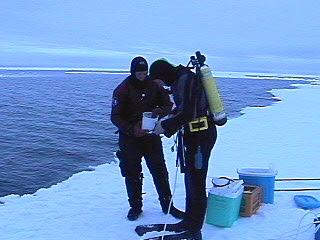
|
|
12 July, 2001
Happy Trails
Thursday, 12 July 2001
Valkommen! (Welcome!)
Life on Board
Well, tonight we had a formal dinner party to officially say goodbye to
some of the scientists who will be helicoptered off the icebreaker to
Longyearben in Spitzbergen in several different flights on Saturday and
Sunday. The reason we did it tonight is because tomorrow night we should
be on another station and often people don't have time to stop and have
dinner during stations. The menu was a beautiful traditional Swedish
buffet with cheeses, many kinds of pickled and flavored herring, potatoes,
and Swedish meatballs. The cooks outdid themselves. The tradition is to
eat the herring then break into a traditional toasting song to the honored
guests. So, many songs in all of the Scandinavian languages were springing
up from groups around the room. Apparently, this is taken fairly seriously
since everyone else in the room is quiet while a song is being sung. The
five Americans onboard, Kristen Riser from Scripps Institute of
Oceanography in La Jolla, Michael Jensen from the Cooperative Institute for
Research in Environmental Sciences in Boulder, CO, Scott Abbott from NCAR
in Boulder, Brian Thompson from Bigelow Laboratory for Ocean Sciences in
Boothbay Harbor, Maine, and myself, all felt pretty lame since we donít
have a traditional Goodbye Toasting song. After much thought and
discussion, we decided that we should sing, "Happy Trails (until we meet
again)" to honor our new friends that were leaving. Everyone in the room
was silent as we sang the entire song then they applauded at the end. I
guess we did alright for the U.S.
Where Are We Now?
The scientists finished up on the ice as the fog closed in this afternoon.
We left for an Open Water station this evening but first the Oden drove by
to pick up some scientists from the Biogeochemical group who were working
on top of an iceberg (maybe 20 feet tall) that had become trapped in the
pack ice. They were cutting blocks of ice from the iceberg for analysis.
They believe these large blocks of old ice may contain ancient gases
trapped in pockets that can give clues about the atmosphere in the past.
We were at Marginal Ice Zone Station D (81o17íN/24o53íE) all day, moored to
a fairly small floating ice floe.
Scientists at Work
After lunch, I went onto the ice with divers Yanna and Kristen to help them
and photograph their endeavors. Their job is to vacuum off and collect the
brown algae that lines the underside of the ice and collect any other
specimens that they see, using a nail stuck into a broomstick as a spear to
collect the small polar cod which live close to the ice bottom. They also
have an underwater videocam, which they use to photograph the blue and
white under-ice world. While they were diving, two Arctic diving birds,
Black Guillemots, paddled over to investigate, already having learned that
the vacuuming process can stir up goodies for them as well. They float
around on the surface, scanning with their heads under the water, then
suddenly disappear from the surface when they spot something good to chase
down below.
As we were rapidly steaming to our next station later that evening, someone
spotted a polar bear out on the ice and put out the call. I didn't have
time to get my camera but it was a large male with a seal kill on a small
ice floe close to the boat. On the next floe, a female and cub waited.
Vi ses! (See you later!)
From Deck 4 on the Icebreaker Oden, somewhere north of Spitzbergen,
Dena Rosenberger

Contact the TEA in the field at
.
If you cannot connect through your browser, copy the
TEA's e-mail address in the "To:" line of
your favorite e-mail package.
|
